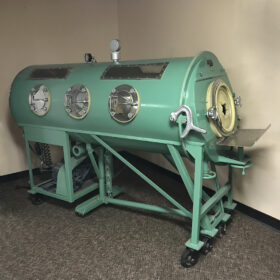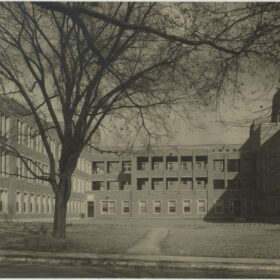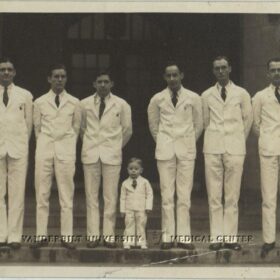Polio patients, iron lung respirators, and…hey, is that Pat Boone??!!
Polio was a terrifying disease, once filling wards at VUMC with paralyzed patients in iron lungs. Vaccines have saved us from all that.
May 15, 2023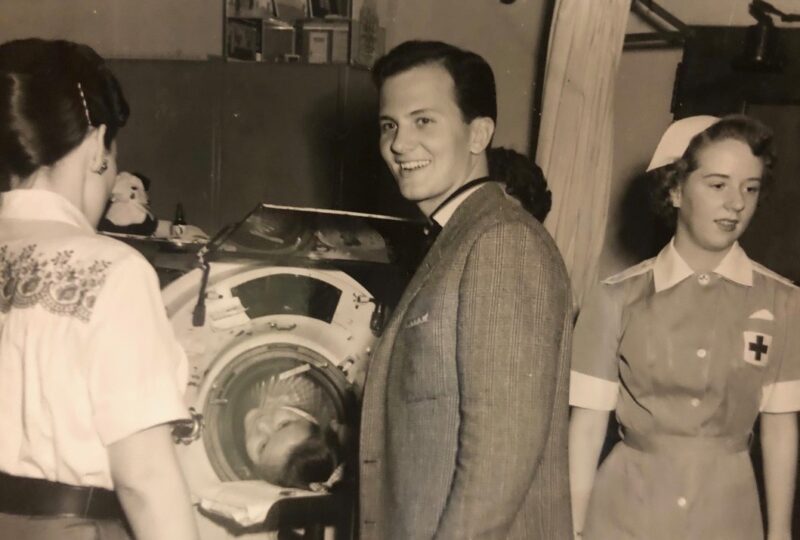
In the late 1950s, when Pat Boone was at the height of his fame, he came by VUMC to visit patients, some of whom were in iron lungs.
The wards of Vanderbilt University Hospital once were filled with the thrum of the motors and the whoosh of the bellows that accompanied the operation of iron lungs — life-saving respirators that kept alive patients paralyzed by polio.
An iron lung is a metal, body-length tube with a motor and bellows apparatus at one end that used rising and falling pressure to force air in and out of a patient’s lungs. The patient’s head is outside the tube at one end.
The iron lung was, in its time, a medical miracle. Thousands of patients afflicted with polio, who would otherwise have died, were saved because of its use.
“Growing up, I was not permitted to go to public swimming pools because my parents feared I might pick up the virus from other children,” recalled William Schaffner, MD, professor of Preventive Medicine.
As direct experience with polio fades with time it’s easy to forget, but polio was a terrifying disease. Carried by a virus, it spread person to person, often in children, who could catch it while swimming or playing with other children. While many cases were mild or even asymptomatic, a small number were devastating, leading to paralysis.
Parents lived with a fear, always in the back of their minds, that polio could strike their child.
“Growing up, I was not permitted to go to public swimming pools because my parents feared I might pick up the virus from other children,” recalled William Schaffner, MD, professor of Preventive Medicine.
While some patients could live outside of the “tank” for part of a day, others needed its help to breathe around the clock. Whenever a patient was inside, he or she was completely dependent on others for care – food, hygiene, companionship, mobility – everything.
Sometimes when Schaffner speaks to community groups he mentions something significant: when the design for Monroe Carell Jr. Children’s Hospital at Vanderbilt was first being considered more than two decades ago, planners did not have to make allowances for the treatment of children using iron lungs.
“We did not put in a ward allocating space and personnel for this disease,” Schaffner says. Thanks to the polio vaccines developed in the 1950s by Albert Sabin and Jonas Salk, and the mass vaccination program instituted by the government to be sure that everyone received the immunizations, “we have eliminated the need.”
He also makes the point that polio isn’t even entirely a thing of the past; recently a young man in New York, who was unvaccinated, acquired paralytic polio after being exposed to a person carrying the virus. Thankfully, such cases are now rare, but point to the need for continued vaccination and vigilance.
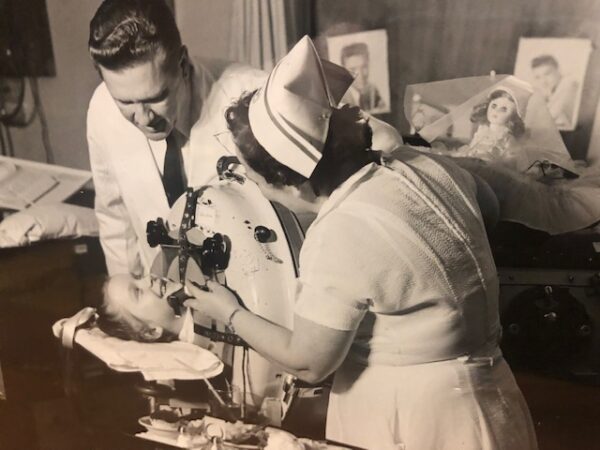
Randolph Batson, MD, and Nita Dison, LPN, with a patient in an iron lung at VUMC in the 1950s.
Basically, though, generations have now grown up with no direct threat of this once dread disease. Hospital wards are not filled with patients who need help to breathe due to paralysis.
This was not always the case at VUMC. The building we now call Medical Center North in the past housed hundreds of patients being treated with iron lungs. Vanderbilt was a regional referral center for polio patients.
In 1951 there were 150 polio patients admitted to Vanderbilt and most of them had rather severe paralysis.
In the Medical Center Archives, letters and notes from some hospital leaders at that time tell the story. A 1951 letter written by Dr. Randolph Batson, professor of Pediatrics and later Dean of the School of Medicine, notes that “Our annual polio admissions have not been below 120 for the past three years” and adds that in 1951 there were 150 polio patients admitted to Vanderbilt and that “most of them had rather severe paralysis,” and 35 of those patients required respirators.
By the late 1950s the incidence of polio was on the wane, but VUMC still admitted dozens of patients who needed an iron lung to breathe.
It was into that world that one of the most unusual celebrity visits in the history of VUMC took place.
Pop singer Pat Boone was at the height of his popularity, and “pop singer” doesn’t quite capture how large he loomed in the entertainment world of that era. He had hit records on the radio – dozens of them – as well as his own TV variety show and a string of popular movies. The guy was everywhere. Including, one day, at VUMC.
Boone had grown up in Nashville, and while it’s lost to history exactly how he came to drop by Vanderbilt Hospital, a photo in the Medical Center Archives shows that he came by to visit patients and was photographed smiling broadly alongside a patient in an iron lung.
Even into the early 1960s, treatment of polio patients remained a significant proportion of VUMC’s mission.
Don Adair, who later became director of Respiratory Care at Vanderbilt, began work as a student in 1961. He recalled walking into the hospital on his first day.
“There was a room full of people on iron lungs—all polio victims,” he said in an article written upon his retirement in 2005. “This was only a few years after the Salk vaccine had come into wide use, and hundreds of polio victims were still in hospitals all over the U.S.”
As better and more modern means of artificial respiration were invented, iron lungs were phased out.
But the lives they saved continue. Those patients who survived polio thanks to the care they received in iron lungs are older now, but continue to live among us, as do their children and grandchildren.
To read the story, “I was the last person in an iron lung at Vanderbilt University Medical Center,” click here.
(Thanks to James Thweatt in the Medical Center Archives, Craig Rooks in Respiratory Care and Bud Cobin in Inventory Management for their help researching this story. Photos from the Medical Center Archives.)







